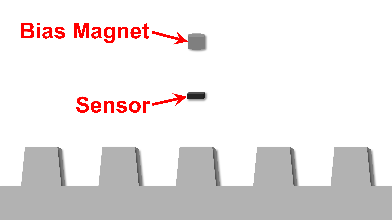
In
this Issue
• Amazing Omnidirectional
Sensors
• Big Gear Sensing and Defect Detection
Amazing Omnidirectional Sensors
 Magnetoresistive
sensors are sensitive in-plane, while Hall effect sensors are sensitive perpendicular
to the IC plane. NVE’s amazing omnidirectional
sensors combine the best of both worlds as they’re sensitive in both
directions and anything between. This remarkable performance is made possible
by a unique dual-sensing layer in the Tunneling Magnetoresistance (TMR) structure,
which allows a single sensor to detect magnetic fields in any direction. Magnetoresistive
sensors are sensitive in-plane, while Hall effect sensors are sensitive perpendicular
to the IC plane. NVE’s amazing omnidirectional
sensors combine the best of both worlds as they’re sensitive in both
directions and anything between. This remarkable performance is made possible
by a unique dual-sensing layer in the Tunneling Magnetoresistance (TMR) structure,
which allows a single sensor to detect magnetic fields in any direction.
The sensors are also “omnipolar,” so unlike Hall sensors, magnet polarity
doesn’t matter. Also unlike Hall effect sensors, these sensors have an ultrawide
sensing range that makes them virtually impossible to saturate.
The omnidirectional sensors come in an ultraminiature 1.1 x 1.1 mm DFN package
and consume low microwatts without duty cycling.
An omnidirectional analog sensor and two omnidirectional magnetic switches are
available:
Part No.
(click for more information) |
Output |
Magnetic Range |
Supply Voltage |
Supply Current |
| AKT001-14E |
Analog |
50 to 800 mT |
0 to 5.5 V |
5 µA @5 V |
| AHK991-14E |
Magnetic
Switch |
350 mT
Operate Point |
0.9 to 1.8 V |
2 µA @1.5 V |
| ADK991-14E |
2.4 to 4.2 V |
1 µA @3 V |
 A
breakout board is
also available for the omnidirectional analog sensor. A
breakout board is
also available for the omnidirectional analog sensor.
This video demonstrates the magic of these remarkable sensors:

Big Gear Sensing and Defect Detection
Our gear-tooth
sensors can be used to detect gear pitches from 0.5 to 6 mm (0.16 to
2 mm module). But what about larger gears?

Larger gears can be detected with back-biased analog sensors much like a proximity
sensor. This allows sensing unlimited gear pitch.
This new video demonstrates with a half-inch pitch (4 mm module) linear rack
gear and a new, ultrasensitive TMR analog sensor:
We also show how the sensor can detect an out-of-spec tooth. The back-biased sensing
method can be used to detect defects in gears, pipes, or cables.
We used an ultrahigh sensitivity ALT002-14E
sensor breakout board.
The sensor has best-in-class sensitivity and large output signals. The sensor
is available in a 1.1 mm DFN, a 2.5 mm DFN, or coming soon, a 0.55 mm
wafer-level chip-scale part.
Download the ALT-Series
Sensor Datasheet » |
|



